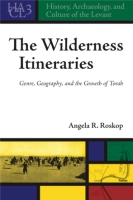The Wilderness Itineraries
Genre, Geography, and the Growth of Torah
Angela Roskop
As we read the wilderness narrative, we are confronted with a wide variety of cues that shape our sense of what kind of narrative it is, often in conflicting ways. It often appears to be history, but it also contains genres and content that are not historiographical. To explain this unique blend, Roskop charts a path through Akkadian and Egyptian administrative and historiographical texts, exploring the way the itinerary genre was used in innovative ways as scribes served new literary goals that arose in different historical and social situations. She marries literary theory with philology and archaeology to show that the wilderness narrative came about as Israelite scribes used both the itinerary genre and geography in profoundly creative ways, creating a narrative repository for pieces of Israelite history and culture so that they might not be forgotten but continue to shape communal life under new circumstances.
- Description
- Table of Contents
The itinerary notices also play an important role in the growth of the Torah. Many scholars have expressed frustration with historical criticism because it seems at times to focus more on deconstructing a narrative than explaining how this composite text manages to work as a whole. The Wilderness Itineraries explores the way that fractures in the itinerary chain and geographical problems serve both as clues to the composition history of the wilderness narrative and as cues for ways to navigate these fractures and read this composite text as a unified whole. Readers will gain insight into the technical skill and creativity of ancient Israelite scribes as they engaged in the process of simultaneously preserving and actively shaping the Torah as a work of historiography without parallel.
Preface
List of Abbreviations
The Torah as History: Rethinking Genre
Emplotment and Repertoire: A Reading Strategy
Itineraries: Their Forms and Contexts
Experimenting with Genre: Using Sources and Shaping Narratives
An Israelite “Annal”
The Routes of the Wilderness Sojourn: Itineraries and Composition History
Geography: Embedding Text in Culture
Epilogue
Indexes
Mailing List
Subscribe to our mailing list and be notified about new titles, journals and catalogs.




